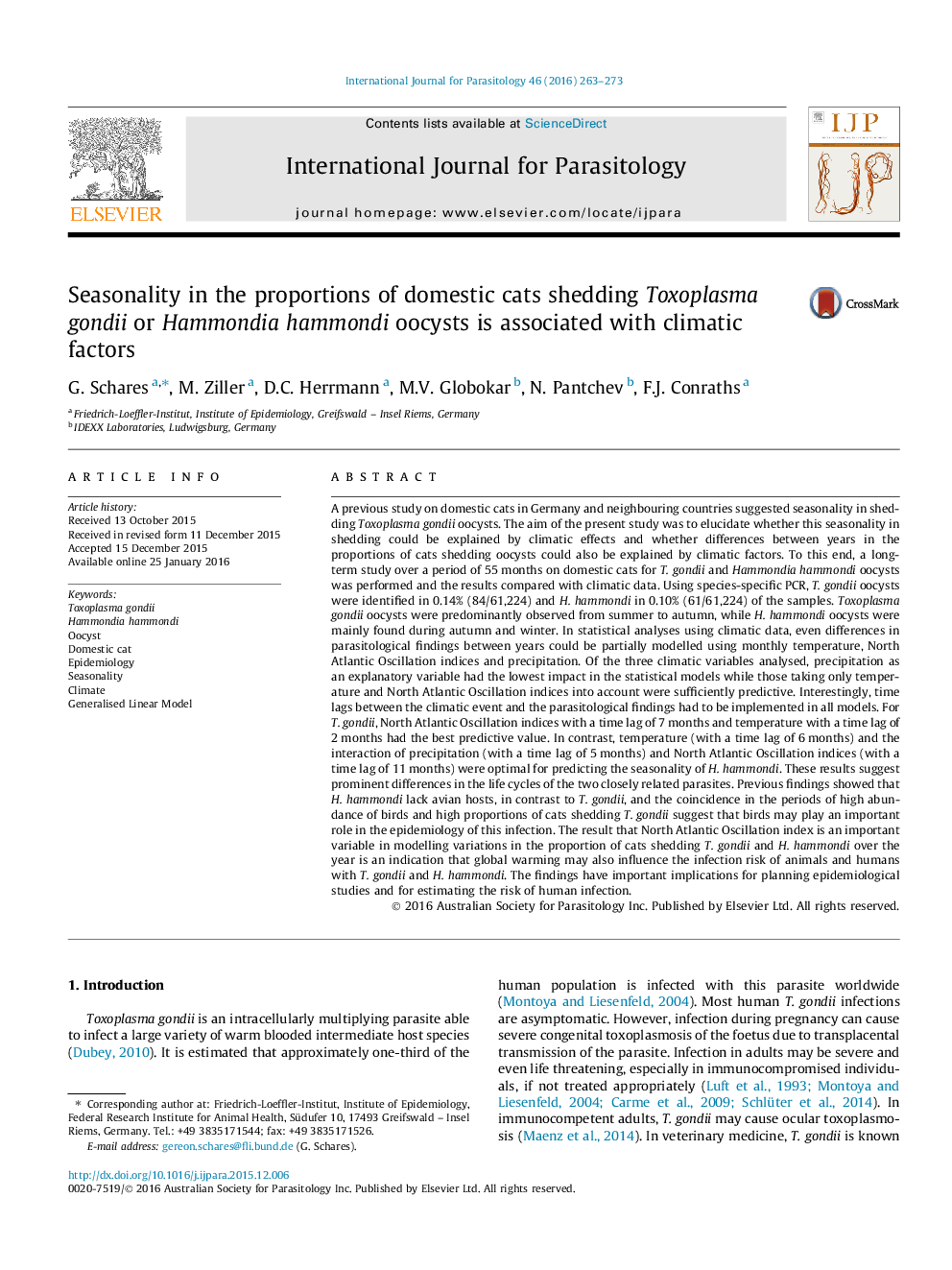| کد مقاله | کد نشریه | سال انتشار | مقاله انگلیسی | نسخه تمام متن |
|---|---|---|---|---|
| 2435955 | 1107234 | 2016 | 11 صفحه PDF | دانلود رایگان |
• Cats shedding Toxoplasma gondii oocysts were predominantly observed from summer to autumn.
• Cats shedding Hammondia hammondi oocysts were mainly found during autumn and winter.
• Seasonality in the proportions of domestic cats shedding T. gondii or H. hammondi were associated with climatic factors.
• Models predicting shedding of T. gondii or H. hammondi include temperature, precipitation and North Atlantic Oscillation.
• Predictive models for cats shedding T. gondii or H. hammondi suggest important differences in life cycles of both parasites.
A previous study on domestic cats in Germany and neighbouring countries suggested seasonality in shedding Toxoplasma gondii oocysts. The aim of the present study was to elucidate whether this seasonality in shedding could be explained by climatic effects and whether differences between years in the proportions of cats shedding oocysts could also be explained by climatic factors. To this end, a long-term study over a period of 55 months on domestic cats for T. gondii and Hammondia hammondi oocysts was performed and the results compared with climatic data. Using species-specific PCR, T. gondii oocysts were identified in 0.14% (84/61,224) and H. hammondi in 0.10% (61/61,224) of the samples. Toxoplasma gondii oocysts were predominantly observed from summer to autumn, while H. hammondi oocysts were mainly found during autumn and winter. In statistical analyses using climatic data, even differences in parasitological findings between years could be partially modelled using monthly temperature, North Atlantic Oscillation indices and precipitation. Of the three climatic variables analysed, precipitation as an explanatory variable had the lowest impact in the statistical models while those taking only temperature and North Atlantic Oscillation indices into account were sufficiently predictive. Interestingly, time lags between the climatic event and the parasitological findings had to be implemented in all models. For T. gondii, North Atlantic Oscillation indices with a time lag of 7 months and temperature with a time lag of 2 months had the best predictive value. In contrast, temperature (with a time lag of 6 months) and the interaction of precipitation (with a time lag of 5 months) and North Atlantic Oscillation indices (with a time lag of 11 months) were optimal for predicting the seasonality of H. hammondi. These results suggest prominent differences in the life cycles of the two closely related parasites. Previous findings showed that H. hammondi lack avian hosts, in contrast to T. gondii, and the coincidence in the periods of high abundance of birds and high proportions of cats shedding T. gondii suggest that birds may play an important role in the epidemiology of this infection. The result that North Atlantic Oscillation index is an important variable in modelling variations in the proportion of cats shedding T. gondii and H. hammondi over the year is an indication that global warming may also influence the infection risk of animals and humans with T. gondii and H. hammondi. The findings have important implications for planning epidemiological studies and for estimating the risk of human infection.
Figure optionsDownload high-quality image (46 K)Download as PowerPoint slide
Journal: International Journal for Parasitology - Volume 46, Issue 4, April 2016, Pages 263–273
